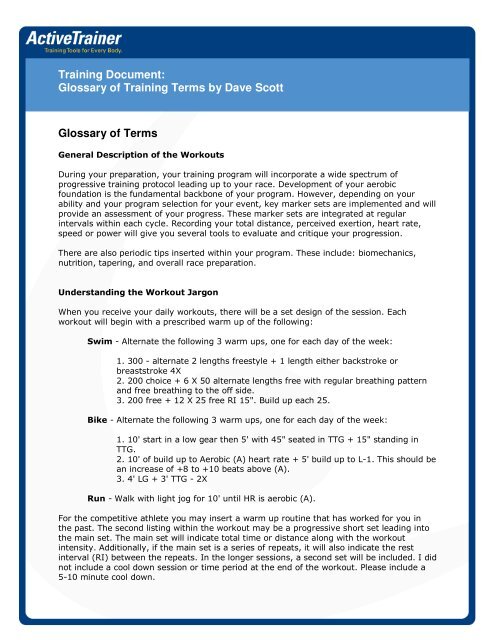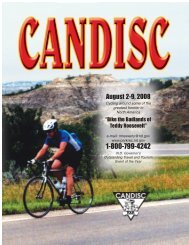Training Document: Glossary of Training Terms by ... - Active.com
Training Document: Glossary of Training Terms by ... - Active.com
Training Document: Glossary of Training Terms by ... - Active.com
You also want an ePaper? Increase the reach of your titles
YUMPU automatically turns print PDFs into web optimized ePapers that Google loves.
<strong>Training</strong> <strong>Document</strong>:<br />
<strong>Glossary</strong> <strong>of</strong> <strong>Training</strong> <strong>Terms</strong> <strong>by</strong> Dave Scott<br />
<strong>Glossary</strong> <strong>of</strong> <strong>Terms</strong><br />
General Description <strong>of</strong> the Workouts<br />
During your preparation, your training program will incorporate a wide spectrum <strong>of</strong><br />
progressive training protocol leading up to your race. Development <strong>of</strong> your aerobic<br />
foundation is the fundamental backbone <strong>of</strong> your program. However, depending on your<br />
ability and your program selection for your event, key marker sets are implemented and will<br />
provide an assessment <strong>of</strong> your progress. These marker sets are integrated at regular<br />
intervals within each cycle. Recording your total distance, perceived exertion, heart rate,<br />
speed or power will give you several tools to evaluate and critique your progression.<br />
There are also periodic tips inserted within your program. These include: biomechanics,<br />
nutrition, tapering, and overall race preparation.<br />
Understanding the Workout Jargon<br />
When you receive your daily workouts, there will be a set design <strong>of</strong> the session. Each<br />
workout will begin with a prescribed warm up <strong>of</strong> the following:<br />
Swim - Alternate the following 3 warm ups, one for each day <strong>of</strong> the week:<br />
1. 300 - alternate 2 lengths freestyle + 1 length either backstroke or<br />
breaststroke 4X<br />
2. 200 choice + 6 X 50 alternate lengths free with regular breathing pattern<br />
and free breathing to the <strong>of</strong>f side.<br />
3. 200 free + 12 X 25 free RI 15". Build up each 25.<br />
Bike - Alternate the following 3 warm ups, one for each day <strong>of</strong> the week:<br />
1. 10' start in a low gear then 5' with 45" seated in TTG + 15" standing in<br />
TTG.<br />
2. 10' <strong>of</strong> build up to Aerobic (A) heart rate + 5' build up to L-1. This should be<br />
an increase <strong>of</strong> +8 to +10 beats above (A).<br />
3. 4' LG + 3' TTG - 2X<br />
Run - Walk with light jog for 10' until HR is aerobic (A).<br />
For the <strong>com</strong>petitive athlete you may insert a warm up routine that has worked for you in<br />
the past. The second listing within the workout may be a progressive short set leading into<br />
the main set. The main set will indicate total time or distance along with the workout<br />
intensity. Additionally, if the main set is a series <strong>of</strong> repeats, it will also indicate the rest<br />
interval (RI) between the repeats. In the longer sessions, a second set will be included. I did<br />
not include a cool down session or time period at the end <strong>of</strong> the workout. Please include a<br />
5-10 minute cool down.
<strong>Training</strong> <strong>Document</strong>:<br />
<strong>Glossary</strong> <strong>of</strong> <strong>Training</strong> <strong>Terms</strong> <strong>by</strong> Dave Scott<br />
Within each <strong>of</strong> the workouts there are notations for each discipline. Following are the<br />
specific abbreviations:<br />
Heart Rate (HR) – heart rate is implemented in the workouts to determine specific training<br />
workloads. For example, after the main set there may a notation that either indicates;<br />
aerobic (A), level 1 <strong>of</strong> your lactate threshold heart rate (L1), level 2 (L2) or level 3 (L3).<br />
Please refer to the heart rate information sheet for further descriptions.<br />
Speed – speed is indicated on several marker sets to record your actual training pace or<br />
speed. For example, pace per mile in running, miles per hour in cycling, pace per 100 yards<br />
or meters in swimming. Perceived exertion (PE) measures an objective workload based on a<br />
1 to 10 PE scale. Please refer to the attached Perceived Exertion information sheet for<br />
further descriptions.<br />
Power – measures average and peak wattage. Power meters can be integrated with HR,<br />
speed, PE, and overall time or distance.<br />
Marker Sets (MS) - are test sets that will be included throughout your cycle. The sets<br />
allow you to evaluate your progress <strong>by</strong> <strong>com</strong>paring heart rates, workloads, send<strong>of</strong>f, repeat<br />
times, speed, perceived exertion and power. The sets will vary from straight sets to repeat<br />
sets with an infinite variety <strong>of</strong> physical and mental inter-play. Marker sets are the true<br />
predictors <strong>of</strong> your potential race performance.<br />
Main Set (M) – this indicates the key set <strong>of</strong> the session. All the variables indicating<br />
workload will be noted. The main set <strong>com</strong>prises 40-80% <strong>of</strong> the entire workout.<br />
Second Set (SS) – is a shorter set typically following the main set. It may include specific<br />
details on workload and/or technique work.<br />
SWIM<br />
Bands - circular rubber tubing (i.e. from a mountain bike tire) approximately 10-12 inches<br />
in diameter and 1-2 inches wide. This is placed around your ankles in a figure 8 to stop all<br />
kicking and forces the athlete to concentrate on the ‘front end’ <strong>of</strong> their freestyle. Bands<br />
keep the head and neck in a neutral position allowing the hips and feet to rise upwards.<br />
Additionally, using the bands requires a faster catch on the front end <strong>of</strong> the stroke,<br />
ultimately teaching the athlete how to set his or her elbow properly.<br />
Paddles (Pads) – enhance stroke technique <strong>by</strong> concentrating on subtle wrist flexion,<br />
setting the elbow, forearm pressure and hyperextension <strong>of</strong> the wrist at the finish <strong>of</strong> the<br />
stroke. Paddles also increase the muscular load throughout the stroke cycle.<br />
Buoy - pull buoys are placed between the upper thighs allowing the feet to drag and<br />
simultaneously keeping the hips elevated. Triathletes love buoys because their hips ride<br />
high and require less exertion. I will re<strong>com</strong>mend them occasionally.
<strong>Training</strong> <strong>Document</strong>:<br />
<strong>Glossary</strong> <strong>of</strong> <strong>Training</strong> <strong>Terms</strong> <strong>by</strong> Dave Scott<br />
B&B – band and buoy are worn together to provide slight hip elevation and increased drag.<br />
R.I. – rest interval between repeats.<br />
Send Off – some <strong>of</strong> the advanced sessions indicate a send <strong>of</strong>f time. This includes the<br />
exercise time plus the rest interval and indicates when you will begin the next repeat. i.e. 6<br />
x 50 on 1 minute. If you swim the 50 in 50 seconds, you will have 10 seconds R.I. before<br />
leaving on the 1 minute send <strong>of</strong>f.<br />
FR (freestyle) - the workouts will predominately be freestyle.<br />
CH (choice stroke) – this is your choice <strong>of</strong> stroke inserted on select main sets.<br />
BK (backstroke) – the workouts will predominately be backstroke<br />
BR (breaststroke) – the workouts will predominately be breaststroke<br />
Fly (butterfly) – the workouts will predominately be butterfly stroke<br />
<strong>Training</strong> <strong>Document</strong>:<br />
TB (tennis balls) – held in each hand during specific swim sets. The TB’s heighten the<br />
nerve endings on your palms. Returning to freestyle, your hands will develop a better feel<br />
for the water.<br />
BK Flutter – teaches the athlete to kick from the hips, extend the knee at the <strong>com</strong>pletion<br />
<strong>of</strong> each kick, and maximize the pressure on the surface <strong>of</strong> your foot. Proper form requires<br />
full arm extension with fingers interlaced or fingers holding a kick board with your thumbs<br />
on the surface.<br />
Desc - descending the set or repeat. i.e. 6 x 50 desc. 1-3 & 4-6. Each 50 is progressively<br />
faster <strong>by</strong> 1-2 seconds. The 3 rd and 6 th are the fastest. Repeats 1 & 4 are the same speed,<br />
2 & 5 same, 3 & 6 same.<br />
BIKE<br />
VG – variable gearing enhances muscle recruitment <strong>by</strong> including workloads in the gears that<br />
you do not necessarily favor. Variable gear changes during a race allow your body a subtle<br />
change in workloads and ultimately result in improved economy. VG is implemented<br />
throughout your training program.<br />
Variable Gearing includes 6 gear choices and the revolutions per minute.<br />
LG – low gear seated = 95-110 rpm<br />
LG standing = 80-86 rpm<br />
BG – big gear seated = 56-64 rpm<br />
BG standing = 60-68 rpm<br />
TTG – time trial gear seated = 86-96 rpm<br />
TTG standing = 68-76 rpm
<strong>Training</strong> <strong>Document</strong>:<br />
<strong>Glossary</strong> <strong>of</strong> <strong>Training</strong> <strong>Terms</strong> <strong>by</strong> Dave Scott<br />
Hill – The ideal grade is between 3-5% for developing and fitness athletes and 4-8% for<br />
<strong>com</strong>petitor athletes. All hill sets will need to be adapted to your “hilly” terrain. Overpasses<br />
work fine!<br />
RUN AND BIKE<br />
Pickups (PU) – are segments <strong>of</strong> 10 seconds to 1 minute.<br />
Run pickups are at 5K to 10K race pace or slightly faster.<br />
Bike pick ups start in a lower gear (higher rpm) and shift up to your time trial gear<br />
as the segment progresses.<br />
For example, a run pickup <strong>of</strong> 6 x 30 seconds with a rest interval <strong>of</strong> 1 minute is done<br />
as follows:<br />
Run for 30 seconds increasing your turnover throughout the 30 second<br />
segment. Jog lightly for 1 minute and repeat the effort. Leg turnover is the<br />
key element <strong>of</strong> these short sessions.<br />
Bricks – there are two forms <strong>of</strong> bricks, run-bike-run, and bike-run-bike. These are included<br />
in the triathlon programs as a marker sets.




